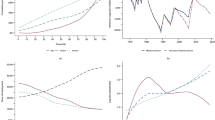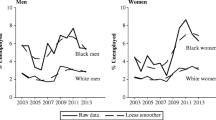Abstract
We assess whether occupational segregation in metropolitan labor markets is associated with the wages of, and contributes to racial/ethnic wage disparities among, less-educated men. To measure occupational segregation in metropolitan low wage markets, we create a segregation index measuring segregation between white, black, and Latino male high school-only educated workers and high school dropouts in 95 metropolitan labor markets utilizing a unique dataset of the structural characteristics of the ninety-five largest US metropolitan labor markets. We use regression, fixed effects, and generalized least squares estimation techniques to test whether this index is associated with wages and racial wage inequality among these men. The analyses reveal that in metropolitan labor markets characterized by more racial and ethnic segmentation in the low wage market, wages are lower among black and Latino men in particular, and racial-ethnic wage disparities among similarly less-educated white, black, and Latino men are higher.

Similar content being viewed by others
Notes
Because of limitations of the dataset, we do not distinguish between GED-holders and high-school graduates.
This index was created using the STATA command, egen newvar = group (occupationvar industryvar).
Because of changes in the industry and occupational coding in the more detailed categories between 1990 and 2000, we had to aggregate the 3-digit occupation and industry codes to 1-digit for comparability across the Census years. Previous research has found that greater occupational detail often reveals wider disparities (Bielby et al. 1986). Thus, testing these associations at lower levels of aggregation, as we do here, offers a more stringent and rigorous test and likely understates the effect.
Percent minority and residential segregation measure different phenomena and are not overlapping measures. (Massey and Denton 1988).
To calculate the percent change in the dependent variable in a semi-log model where Y (wages) is logged (natural log), we use the 100 * (eβ −1).
References
Andersson, Fredrik, Harry J. Holzer and Julia I. Lane. 2005. Moving Up Or moving on : Who advances in the Low-wage labor market?New York: Russell sage foundation.
Bayer, Patrick J., Stephen L. Ross and Giorgio Topa. Place of work and place of residence: informal hiring networks and labor market outcomes national bureau of economic research working paper series. 2005
Beggs JJ, Villemez WJ, Arnold R Black population concentration and blackwhite inequality: expanding the consideration of place and space effects. Soc Forces. 1997;76:65–91.
Bielby, William T; Baron, James N. Men and Women at Work: Sex Segregation and Statistical Discrimination. American Journal of Sociology, 1986 Volume 91, Issue 4.
Blalock HM Economic discrimination and negro increase. Am Sociol Rev. 1956;21:584–8.
Blanchflower, David and Andrew Oswald. The Wage Curve Reloaded, (July). IZA Discussion Paper No. 1665. Available at SSRN: http://ssrn.com/abstract=761607, NBER Working Papers: 2005 11338.
Calvo-Armengol A, Jackson M. Networks in labor markets: Wage and employment dynamics and inequality. J Econ Theory. 2007;132(1):27–46.
Castles S, Miller MJ The Age of migration : international population movements in the modern world. 4th, rev. &. updated ed. New York: Guilford Press; 2009.
Catanzarite L. The dynamics of segregation and earnings in brown-collar occupations. Work Occup. 2002;29:300–45.
Catanzarite L. Race-gender composiion and occupational pay degradation. Soc Probl. 2003;50:14–37.
Coleman MG Job skill and black male wage discrimination*. Soc Sci Q. 2003;84(4):892–906.
Cutler DM, Glaeser EL Are ghettos good or bad?*. Q J Econ. 1997;112(3):827–72.
Darity W. Economic theory and racial economic inequality. Rev Black Poli Econ. 1975;5(3):225–4.
Dickerson. Is racial exclusion gendered? The role of residential segregation in the employment status of black women and men in the US. Fem Econ. 2002;8(2):199–208.
Dickerson. Black employment, segregation, and the social organization of metropolitan labor markets. Econ Geogr. 2007;83(3):283–307.
Dickerson. Occupational and Residential Segregation: The Confluence of Two Systems of Inequality. Labor Studies Journal. 2008 Vol. 33, .
Falcon, Luis M. Social networks and employment for Latinos, Blacks, and Whites. New England. J Public Policy. 1995;11(1):4.
Falcon, E. and Melendez 2001. “Racial and ethnic differences in job searching in urban centers”, in Urban Inequality: Evidence from Four Cities
Green GP, Tigges LM, Diaz D. Racial and ethnic differences in job-search strategies in Atlanta, Boston, and Los Angeles. Soc Sci Q (University of Texas Press). 1999;80(2):263.
Hamilton D, Algernon A, Darity WJ Whiter jobs higher wages: occupational segregation and the lower wages of black men. Economic Policy Institute Briefing: Paper; 2011.
Hellerstein JK, Neumark D. Workplace segregation in the United States: race, ethnicity, and skill. Rev Econ Stat. 2008;90(3):459–77.
Hellerstein, Judith K. McInerney, Melissa and David Neumark. 2008. Measuring the Importance of Labor Market Networks IZA Discussion Paper No. 3750.
Holzer HJ, Danziger S. Are jobs available for disadvantaged workers in urban areas? In: Bobo LD, editor. Urban inequality: evidence from four cities. O'Connor, Alice. Tilly, Chris. Russell Sage Foundation: Multi-City Study of Urban Inequality series. New York; 2001. p. 496–538.
Holzer H, Nightingale D. Reshaping the American workforce in a changing economy. Washington, DC: The Urban Institute Press; 2007.
Holzer H, Reaser J. Black applicants, Black Employees, and Urban Labor Market Policy. J Urban Econ. 2000;48:365–87.
Holzer HJ, Lane JI, Vilhuber L. Escaping low earnings: the role of employer characteristics and changes. Ind Labor Relat Rev. 2004;57(4):560–78.
Huffman ML, Cohen PN Racial wage inequality: job segregation and devaluation across U.S. Labor markets. Am J Sociol. 2004;109(4):902–36.
Katz L. Efficiency wages: a partial evaluation. Natl Bur Econ Res Macroecon Annu. 1986;1:235–40.
Kennedy P A guide to econometrics. Cambridge, MA: MIT Press; 2006.
Kmec JA Minority job concentration and wages. Soc Probl. 2003;50(1):38–59.
Lang K, Manove M, Dickens WT Racial discrimination in labor markets with posted wage offers. Am Econ Rev. 2005;95(4):1327–40.
Laschever, Ron A. The doughboys network: social interactions and the employment of world war I veterans 2009.
Lichter, Michael I. and Melvin L. Oliver. 2000. “Racial Differences in Labor Force Participation and Long-Term Joblessness Among Less-Educated Men” Pp 611 in Prismatic Metropolis : Inequality in Los Angeles, Edited by L Bobo New York: Russell Sage Foundation.
Liu CY Latino immigration and the low-skill urban labor market: the case of Atlanta. Soc Sci Q. 2012;94(1):131–57.
Loury LD. Some contacts are more equal than others: informal networks, job tenure, and wages. J Labor Econ. 2006;24(2):299–318.
Mason PL Male interracial wage differentials: competing explanations. Cambridge Journal of: Economics; 1999.
Massey DS, Denton NA The dimensions of residential segregation. Social Forces. 1988;67:281–315.
Mishel L, Berstein J, Shierholz H. State of working America 2008/2009. Economic Policy Institute: Washington D.C; 2008.
Moss P, Tilly C Why opportunity Isn't knocking: racial inequality and the demand for labor.” Pp. 444–495 in urban inequality.”why opportunity Isn't knocking: racial inequality and the demand for labor. New York: Russell Sage Foundation; 2001.
Mouw T. Racial differences in the effects of job contacts: Conflicting evidence from cross-sectional and longitudinal data. Soc Sci Res. 2002;31(4):511–38.
Patel K, Vella F. Immigrant networks and their implications for occupational choice and wages[PDF] from Iza: Org IZA Discussion Papers; 2007.
Portes A, Rumbaut RG. Immigrant America: A portrait: University of California Press; 2006.
Royster DA Race and the invisible hand: how white networks exclude black men from blue-collar jobs. Berkeley: University of California Press; 2003.
Small ML Racial differences in networks: do neighborhood conditions matter?*. Soc Sci Q. 2007;88(2):320–43.
Spriggs W, Klein B. Raising the floor: The effects of the minimum wage on Low-wage workers. Washington, DC: Economic Policy Institute; 1994.
Stoll MA, Raphael S, Holzer HJ Black job applicants and The hiring officer's race. Ind Labor Relat Rev. 2004;57(2):267–87.
Tomaskovic-Devey D, Skaggs S. An establishment-level test of the statistical discrimination hypothesis. Work Occup. 1999;26(4):422.
Topa G. Social interactions, local spillovers, and unemployment. Rev Econ Stud. 2001;68:261–34.
U.S. Bureau of Labor Statistics, 2014. Internal Data Analysis.
Weeden K. Occupational segregation. Blackwell Encycl Sociol:. 2007;3244-3247.
Acknowledgments
The authors gratefully acknowledge the helpful suggestions of Darrick Hamilton and the research assistance of Makada Henry and Traci Cosmo.
Author information
Authors and Affiliations
Corresponding author
About this article
Cite this article
von Lockette, N.D., Spriggs, W.E. Wage Dynamics and Racial and Ethnic Occupational Segregation Among Less-Educated Men in Metropolitan Labor Markets. Rev Black Polit Econ 43, 35–56 (2016). https://doi.org/10.1007/s12114-015-9222-5
Published:
Issue Date:
DOI: https://doi.org/10.1007/s12114-015-9222-5




